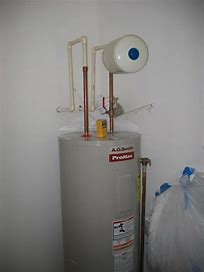Expansion Tanks

Tank Water Heater Expansion Tanks
Did you ever see that round metal tank on top of your water heater and wonder what it was and why it’s there?
Its Likely a water heater expansion tank.
Water heater expansion tanks are mounted in different ways and directions. The preferred method of installation is to install the tank vertically. If the thermal expansion tank is installed horizontally, it should always be supported. In really tight installations it is necessary to install the tank horizontally, but it should never be just left hanging. It should always be supported with solid piping (i.e. copper, stainless galvanized ect…) and always installed on the cold side.
In North Carolina, the installation of water heater expansion tank is a requirement. Beginning in 2012 The North Carolina Plumbing Code: “a device for controlling thermal expansion must be placed between the water heater and any device that can stop water from flowing back to the cold-water source”. This measure is essential because water expands when heated and is an incompressible liquid. Without a thermal expansion tank, the expanding water in your pipes has nowhere to go, potentially causing issues.
Water Heater Expansion Tanks should be visually inspected annually and replaced as necessary. They are not as thick as your water heater tank and can build up sedimate and rust much sooner than your water heater. We recommend replacing them every five years. Picture two is of an expansion tank that needs replacing immediately. I have been in garages where an expansion tank (looking like this one) blew off while the homeowner was not home and the water spraying from it ruined the sheetrock in half of the garage. If you see any signs of rusting, replace the expansion tank immediately.
To replace your expansion tank.
Turn off the power to the water heater.
Turn off the cold water valve to your water heater.
Open a hot water faucet in your home to releive the pressure.
Carefully unscrew the expansion tank.
Install the new expansion tank using teflon tape.
Turn on the cold water valve.
Wait until a solid stream of water is coming from the faucet.
Turn the power on to your water heater.
Check for leaks.


